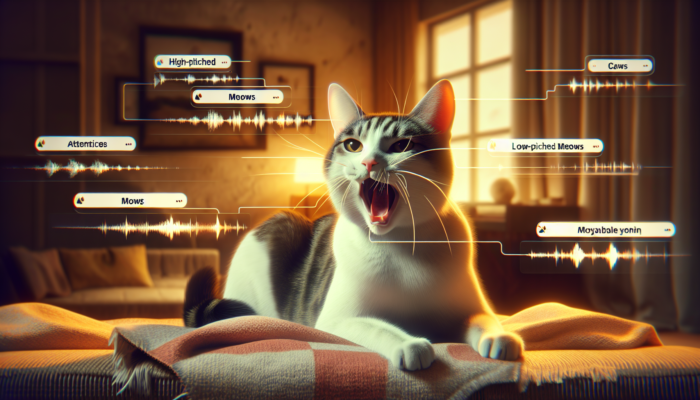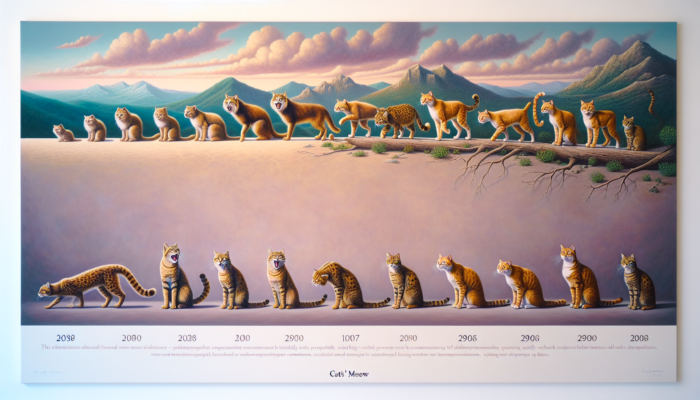Decoding Your Cat’s Meows: A Detailed Exploration of Feline Vocalization and Communication
Understanding the language of cats is essential for every cat parent. Mastering the intricacies of the meow is a fundamental aspect of grasping feline communication. This vocalization serves as one of the principal methods cats use to express a wide range of emotions and needs. By honing your skills in interpreting the various tones and pitches of meowing, you can greatly improve your relationship with your beloved pet, fostering a profound emotional bond based on mutual love and understanding.
Learning the Nuances of Cat Communication: How to Interpret Each Unique Meow

Each meow produced by your cat carries its own specific significance, making it crucial for pet owners to accurately interpret these vocalizations. For instance, a persistent, high-pitched meow may signal your cat’s urgent appeal for attention or food, while a low, short meow often indicates annoyance or discomfort. Additionally, cats frequently modify their tone and rhythm based on their emotional states and surroundings, creating a sophisticated communication system that reflects their feelings and desires.
Research indicates that cats have the ability to adapt their meowing styles to suit the communication preferences of their human companions. This adaptability showcases a remarkable level of awareness; a cat that closely observes its owner can learn to produce sounds that effectively capture their attention. By carefully monitoring the subtle variations in their meows, you can respond more adeptly to your cat’s needs, ultimately deepening your emotional connection.
Exploring the Reasons Behind Cat Meowing: Understanding Feline Emotion and Behavior
Cats engage in meowing for a variety of reasons, with the primary motivation being the need for attention. Domestic cats quickly learn that this vocalization effectively attracts human interest. Additionally, meowing may express feelings of anxiety or boredom. A cat that feels lonely or under-stimulated may resort to meowing as a way of seeking interaction or entertainment, underscoring their dependence on human companionship and connection.
It’s important to recognize that certain breeds are naturally more vocal than others. For instance, Siamese cats are famously known for their frequent and expressive meowing, while other breeds may be more reserved in their vocalizations. By understanding the specific context in which your cat meows, you can respond effectively to their emotional needs, enhancing your bond with your pet.
Utilizing Meowing to Enhance Human Relationships: Bridging the Communication Gap
The meow serves as a distinctive mode of communication that cats primarily utilize to engage with humans. Unlike many other animals, adult cats rarely meow at one another; they predominantly reserve this vocalization for interactions with their human friends. This highlights the importance of this communication method in the relationships we cultivate with our feline companions.
Cats often employ their meows to express fundamental needs such as food, water, or the desire to go outdoors. They may also meow to communicate feelings of happiness or excitement, especially in the presence of their owners. By learning to respond to these meows, you not only fulfill your cat’s basic needs but also promote a deeper emotional connection between both of you.
The Fascinating Evolution and History of Cat Meowing: An Insightful Journey

The evolution of the meow presents a captivating story that chronicles the development of felines. Understanding the origins of this sound provides valuable insights into how cats have crafted their communication methods with humans over the ages.
Examining the Evolutionary Origins of Meowing: From Wild Ancestors to Cherished Pets
The ancestors of domestic cats, such as the African wildcat, did not meow in the manner that modern domestic cats do. These wild felines primarily relied on body language and various vocalizations to communicate. However, as the process of domestication unfolded, cats began to develop meows specifically tailored for interaction with humans, evolving their communication techniques to adapt to their new living conditions.
This evolutionary journey has been shaped by thousands of years of cohabitation with humans, who, often unknowingly, have encouraged these vocalizations through their responses and interactions. Over the years, the meow has transformed into a versatile communication tool, allowing cats to convey their needs and desires in a more effective manner.
The Impact of Domestic Life on Cat Meowing: Insights into Vocalization Changes
The process of domestication has had a profound influence on the evolution of the meow. While wild cats generally utilize more guttural and less diverse vocalizations, domestic cats have developed a wide range of meows that enhance their ability to communicate messages to their human companions. This adaptability has enabled cats to thrive in human households, further reinforcing their status as beloved pets.
Research indicates that cats modify their meowing styles based on human responses, making their vocalizations more engaging and appealing. This transformation has facilitated cats’ seamless integration into family life, solidifying their role as cherished companions.
Recent Insights from Feline Communication Research: Revealing the Secrets of Cat Meowing

A growing body of research is focused on deepening our understanding of the meow and its critical role in feline communication. These studies have uncovered remarkable insights, such as cats’ ability to adjust their meowing based on their audience. For example, a cat might adopt a softer, higher-pitched tone when addressing a child, while using a more assertive tone with an adult.
These revelations pave the way for a greater understanding of the emotional and behavioral needs of cats. By applying this knowledge to your interactions, you can create a more enriching and responsive environment for your cherished feline companions.
Effective Strategies for Engaging with Your Cat’s Meows: Strengthening Your Bond
Learning how to respond effectively to your cat’s meows not only fortifies your bond but also supports their overall well-being. Here are several effective strategies that can aid you in understanding and addressing your cat’s unique needs.
Improving Your Cat Meow Interpretation Skills: Practical Tips for Understanding Feline Vocalizations
To effectively interpret your cat’s meow, it is vital to remain observant and responsive to their vocalizations. Pay attention to the tone and frequency of the meows. A rapid, repetitive meow may indicate excitement or boredom, while a slower, deeper sound could signify a request for comfort or affection, showcasing the emotional context behind their vocalizations.
Moreover, observing your cat’s body language alongside their meows can provide invaluable context. For instance, if a cat meows while rubbing against your legs, they are likely seeking your attention or affection. By incorporating these observations into your responses, you will be better equipped to meet your cat’s needs and emotions effectively.
Responding to Your Cat’s Vocal Requests: Understanding Their Needs Through Meowing
Once you comprehend the context behind your cat’s meows, it is essential to respond appropriately. If your cat meows to go outside, ensure you grant them safe access to explore the outdoors. Similarly, if your cat is signaling a desire for food, be diligent about maintaining their feeding schedule to create a sense of security.
Positively responding to your cat’s meows not only reinforces your emotional connection but also encourages your cat to continue communicating with you, fostering mutual understanding and companionship in your shared life.
Deepening Your Relationship with Your Cat Through Effective Meowing: Cultivating Connection
Utilizing meows as a communication tool can significantly enhance your relationship with your cat. By fostering an environment where your cat feels comfortable to meow, you facilitate positive interactions. This may include engaging in playtime, cuddle sessions, or even training exercises that encourage your cat to express themselves freely without hesitation or fear.
By responding appropriately to your cat’s meows, you signal your attentiveness to their needs, reinforcing trust and affection between you. In this way, the meow evolves from a mere sound into a vital component of a fulfilling and loving relationship.
The Cultural Significance of the Cat Meow: An Exploration of Its Impact in Society
The sound of a cat’s meow carries substantial cultural significance, influencing various forms of media, including music, film, and social networks. Let’s investigate how this iconic sound is represented across diverse mediums.
Meowing in Film and Television: Enhancing Character Development and Storytelling
In cinema and television, the meow often enriches the personalities of feline characters. Movies like “The Aristocats” and television shows such as “Garfield” utilize the meow to convey emotions and character attributes. These portrayals not only entertain audiences but also shape perceptions of cats as affectionate and playful companions.
The meow is frequently employed to create comedic or dramatic moments within narratives. Writers skillfully use this sound to elicit curiosity or agitation from cats, allowing viewers to connect with these feline characters on a more profound emotional level.
The Influence of Meowing in Music and the Arts: Celebrating the Sounds of Felines
The meow has inspired a myriad of musicians and artists throughout history. Iconic songs like “What’s New Pussycat” by Tom Jones creatively incorporate the sound of the meow to evoke themes of love and affection. Additionally, artworks featuring cats often reference the meow, celebrating the unique role these creatures play in human culture and the arts.
These artistic expressions serve not only as tributes to cats but also encapsulate the essence of their behavior and character, making the meow a universally recognized and cherished sound across cultures.
The Viral Boom of Cat Meowing on Social Media: Celebrating Feline Content
Social media platforms have transformed the digital landscape, with videos featuring cats meowing enjoying immense popularity. Platforms like TikTok and Instagram are flooded with content showcasing the delightful sounds of cats, attracting millions of views and likes. These videos not only entertain audiences but also promote awareness about feline communication, nurturing a vibrant community of cat enthusiasts.
Through the meow, cat lovers connect, sharing their experiences and learning more about the behaviors and needs of these fascinating animals. This viral trend has fostered a global community centered around a shared passion for cats and their unique modes of communication.
Understanding the Importance of Meowing for Your Cat’s Health and Well-Being: A Critical Indicator
The meow serves as a vital indicator of your cat’s overall health. Learning to recognize changes in your cat’s meows can help you identify potential health issues early, allowing for timely intervention and care.
Using Meowing to Identify Health Concerns: Recognizing Vocalizations as Health Indicators
A sudden alteration in your cat’s meow could signify distress or illness. For example, a higher-pitched or more frequent meow might indicate pain or anxiety, whereas an unusual silence may point to underlying health issues that require further investigation.
It’s essential to pay close attention to your cat’s vocalizations and monitor any changes in their meowing patterns. If you observe an abnormal meow that persists or is accompanied by other concerning symptoms, consulting a veterinarian is advisable to evaluate your pet’s health and well-being.
The Role of Meowing in Promoting Mental Health: Supporting Your Cat’s Emotional Wellness
The meow plays a crucial role in maintaining your cat’s mental health. Cats that feel secure and loved often meow joyfully during interactions with their owners. Conversely, a cat that feels neglected or bored may resort to excessive meowing as a means of seeking attention or engagement from their human companions.
Creating a stimulating environment filled with playtime, interaction, and mental challenges can encourage positive meowing. This approach not only benefits your cat’s mental health but also cultivates a more harmonious relationship between you and your feline friend.
Knowing When to Seek Veterinary Care for Meowing Issues: Ensuring Optimal Health
Do not disregard any changes in your cat’s vocalizations. If you observe an unusual meow, especially if it accompanies symptoms like lethargy or loss of appetite, it’s crucial to consult a veterinarian promptly to rule out any serious health concerns.
A professional can assess your cat’s condition, conduct necessary examinations, and recommend appropriate treatment if required. By closely monitoring your cat’s vocal behavior, you can take timely action to ensure their health and well-being.
Encouraging Positive Meowing: Techniques to Inspire Healthy Vocalizations
Promoting a positive meow can significantly enhance your cat’s experiences and solidify your bond. Here are some effective techniques to encourage healthy and joyful vocalizations from your feline friend.
Engaging Interactive Games to Stimulate Positive Meows: Fun Techniques for Connection
Participating in interactive play is one of the most effective methods to inspire a positive meow. Toys that mimic the movements of prey, like feather wands or laser pointers, can excite your cat to meow joyfully during play. These sessions provide both mental and physical stimulation, leading to happy vocal expressions that reflect your cat’s contentment.
Furthermore, scheduling regular playtime helps to create an atmosphere where your cat feels free to express themselves. By incorporating play into your daily routine, you can cultivate a joyful meow that strengthens the bond between you and your feline companion.
Training Your Cat to Meow on Command: Enhancing Communication Skills
Training can be an effective way to teach your cat to meow on command. By utilizing positive reinforcement techniques, such as treats and verbal praise, you can associate a specific word or gesture with the act of meowing. This practice not only improves your communication skills but also encourages your cat to express themselves more freely and confidently.
Moreover, training your cat to meow on command can serve as a wonderful bonding opportunity, creating cherished moments while enhancing their communication skills and enriching your relationship.
Creating a Cat-Friendly Environment to Promote Positive Meowing: Nurturing Spaces for Vocal Cats
To encourage positive meowing, it’s vital to develop a welcoming and stimulating environment. Ensure your home provides ample play, scratching, and resting areas. Cats thrive on exploration and stimulation, and an enriched environment can inspire joyful vocalizations that reflect their overall well-being.
Additionally, dedicate time daily to interact with your cat. Whether through play, petting, or simply conversing with them, these moments of attention can encourage your cat to meow positively and feel cherished, further solidifying your bond.
The Role of Meowing in Human Relationships: Strengthening Emotional Connections
The meow holds a fascinating position in human relationships, often serving as an emotional bridge. Let’s explore how cats’ meows can impact our interactions and enhance our social bonds.
The Meow as a Connector in Family Interactions: Strengthening Relationships Through Feline Communication
Cats that meow frequently can act as facilitators within families, nurturing interactions and connections among family members. Children, in particular, can develop affectionate relationships with their cats by learning to interpret their meows and respond to their needs, creating a caring environment.
Such interactions strengthen family bonds, cultivating an atmosphere where everyone learns to care for each other. In this context, the meow becomes a symbol of love, empathy, and shared responsibility within the family dynamic.
The Therapeutic Value of Meowing in Animal-Assisted Therapy: Enhancing Emotional Well-Being
Meows can play a crucial role in animal-assisted therapies. Cats are often employed in therapeutic settings to provide comfort and alleviate stress for individuals of all ages. Their ability to meow soothingly creates a calming atmosphere that can be beneficial for patients.
Interacting with cats can help reduce anxiety, promote happiness, and foster emotional stability, demonstrating that the meow can have a profoundly positive effect on mental health and emotional well-being.
Influencing Social Connections Through Meowing: Enhancing Human Bonds via Feline Communication
The meow can shape our social interactions as well. Individuals who share experiences related to their cats’ meows may create emotional connections, fostering friendships and supportive networks. Conversations about meows and cat behavior can strengthen relationships among pet owners and cultivate a sense of community.
Additionally, these discussions can promote dialogue surrounding responsible pet ownership, nurturing a more engaged and compassionate community dedicated to animal welfare and the well-being of our feline friends.
Looking Towards the Future: The Evolution of Cat Meowing and Feline Communication
The future of meowing and feline communication appears bright, with numerous innovations and research initiatives on the horizon. Let’s explore the trends that are shaping our comprehension of this unique language and its evolution.
Technological Advances in Analyzing Cat Meows: Innovations in Feline Linguistics
Recent technological advancements have simplified the process of understanding cats’ meows. Researchers are employing machine learning algorithms to analyze meowing and distinguish various tones and meanings. These innovations hold the potential to revolutionize our capacity to interpret our feline friends’ wants and needs.
Moreover, new mobile applications are emerging that enable cat owners to record and analyze their cats’ meows, offering invaluable insights into their vocal behavior and enhancing the owner-pet relationship.
Anticipating Changes in Meowing: The Evolution of Feline Communication Practices
As our understanding of feline behavior deepens, the methods by which cats meow may also evolve. Cats could learn to meow in even more precise ways to communicate with their humans, further improving their ability to convey their messages effectively.
This evolution could be influenced by shifts in our lifestyles. For example, cats residing in busy urban settings might develop distinct meows tailored to capture their owners’ attention amidst the noise and distractions of city life.
Current Research Trends on Cat Meowing: Ongoing Studies and Their Relevance to Cat Owners
Numerous research projects are currently underway, focusing on various aspects of the meow and its implications for feline health and well-being. These studies investigate the environmental, social, and behavioral factors that affect the vocal language of cats.
The findings from this ongoing research could provide significant advantages for cat owners, enabling them to interpret their pets’ meows more accurately and improve their overall quality of life through enhanced understanding and communication.
Your Questions About Cat Meowing Answered: Common Inquiries Explained
What Causes My Cat to Meow at Night?
Cats may meow at night for various reasons, such as boredom, anxiety, or simply a wish for attention. Ensuring they have adequate stimulation and activities during the day can help minimize nighttime vocalizations, leading to a more restful night for both you and your feline companion.
How Can I Tell If My Cat’s Meow Indicates Distress?
Excessive meowing paired with behaviors such as hiding or restlessness may indicate distress or discomfort. It’s essential to closely monitor your cat’s behavioral changes and consult a veterinarian if necessary to address any underlying issues.
Do All Cats Have the Same Meowing Style?
No, each cat possesses its unique meowing style, influenced by breed, personality, and past experiences. Some cats may naturally be more vocal than others, reflecting their individual temperaments and communication preferences.
Is Meowing a Strategy for Cats to Gain Attention?
Yes, many cats meow to attract their owners’ attention. They quickly learn that this sound can help them achieve their desires, whether it be food, affection, or playtime, showcasing their intelligence and adaptability.
Can Changes in Meowing Indicate Health Problems?
Indeed, a sudden change in a cat’s behavior or vocalization can signal potential health issues. If you notice significant changes in your cat’s meows, it’s advisable to consult a veterinarian to ensure your pet’s health and well-being.
What Strategies Can Help Reduce Excessive Meowing?
To minimize excessive meowing, ensure your cat is mentally and physically stimulated. Engage in interactive play, provide various toys, and spend quality time together to help reduce vocalization and promote a calm environment.
Do Cats Meow Differently as They Age?
Yes, younger cats may meow more frequently than older cats. Kittens tend to be more vocal, while older cats may become quieter as they age, reflecting changes in their communication style and needs.
Can Meowing Indicate Behavioral Problems in Cats?
Yes, excessive or inappropriate meows can signal underlying behavioral issues. Working with an animal behaviorist may help effectively address these challenges and improve your cat’s well-being.
What Are the Signs That Indicate My Cat Is Happy?
A happy cat may meow joyfully, rub against you, and display relaxed body language. These positive signs are excellent indicators of their overall well-being and contentment in their environment.
Is Meowing a Universal Language Among Cats?
While meows may share similar meanings among many cats, each cat has its unique communication style. Owners should strive to learn and interpret their pet’s distinct vocalizations to strengthen their bond and understanding.
Connect with us on Facebook for exclusive updates!
The Article: Meows Explained: Understanding the Language of Cats Appeared First On Unity Pets.
The Article Understanding Cat Language: Meows Explained Was Found On https://limitsofstrategy.com




This exploration into feline meows is so fascinating! I’ve noticed that my cat, Luna, has her own unique sound for different situations—like the distinct “chirp” she gives when she spots a bird outside versus the more demanding yowl when she’s ready for dinner. It’s almost like she has her own little language that only I can understand!